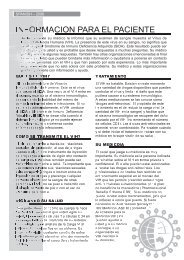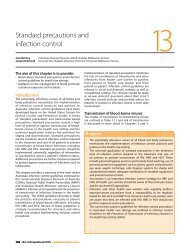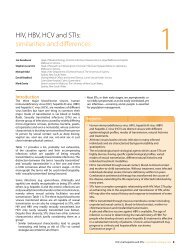B Positive – all you wanted to know about - ASHM
B Positive – all you wanted to know about - ASHM
B Positive – all you wanted to know about - ASHM
You also want an ePaper? Increase the reach of your titles
YUMPU automatically turns print PDFs into web optimized ePapers that Google loves.
the implementation of hepatitis b prevention<br />
and education is crucial <strong>to</strong> increase public<br />
awareness of hepatitis b including the<br />
risk fac<strong>to</strong>rs for transmission, measures for<br />
prevention, and the availability of therapy.<br />
these programs should be designed<br />
specific<strong>all</strong>y for at-risk populations, such as<br />
caLd communities, the aboriginal and <strong>to</strong>rres<br />
strait islander populations, idus, MsM, and<br />
prisoners.<br />
the increasing number of people with chronic<br />
HbV infection and the improved availability<br />
of HbV therapy mandate an enhanced<br />
response <strong>to</strong> treatment and care. this response<br />
should include national guidelines for HbV<br />
diagnosis and moni<strong>to</strong>ring. the establishment<br />
of community hepatitis clinics and the<br />
enhancement of GP shared-care models in<br />
areas with large asian and aboriginal and <strong>to</strong>rres<br />
strait islander populations is also a priority.<br />
fin<strong>all</strong>y, barriers <strong>to</strong> health care service access<br />
among idus, MsM, caLd and aboriginal and<br />
<strong>to</strong>rres strait islander communities include<br />
stigma and discrimination related <strong>to</strong> high-risk<br />
behaviours, the lack of english proficiency,<br />
and cultural differences. therefore, besides<br />
providing training and essential information<br />
related <strong>to</strong> hepatitis b for primary care<br />
practitioners, improving their understanding<br />
of health beliefs, language difficulties, and the<br />
cultural attitudes of affected populations is also<br />
crucial <strong>to</strong> facilitating access <strong>to</strong> health services<br />
for at-risk groups.<br />
References<br />
1. World Health organization. Hepatitis b fact<br />
sheet no 204. 2000 [Last accessed september<br />
2006]; available from: http://www.who.int/<br />
mediacentre/factsheets/fs204/en/print.html<br />
2. World Health organization, department of<br />
communicable diseases surveillance and<br />
response. Hepatitis b; 2002. report no.:<br />
WHo/cds/csr/Lyo/2002.2.<br />
3. World Health organization. introduction<br />
of hepatitis b vaccine in<strong>to</strong> childhood<br />
immunisation services. report no.: WHo/<br />
V&b/01.31.Geneva; 2001.<br />
4. crawford dH, fawcett J. Hepa<strong>to</strong>cellular<br />
carcinoma in australia: largely preventable.<br />
Med J aust 2000; 173: 396-7.<br />
5. nguyen Vtt, razali K, amin J, Law MG, dore<br />
GJ. estimates and projections of hepatitis brelated<br />
hepa<strong>to</strong>cellular carcinoma in australia<br />
among people born in asia-Pacific countries.<br />
J Gastroenterol Hepa<strong>to</strong>l 2007. doi:10.1111/<br />
j.1440-1746.2007.05065.x<br />
6. o’sullivan bG, Gidding Hf, Law M, Kaldor<br />
JM, Gilbert GL, dore GJ. estimates of chronic<br />
hepatitis b virus infection in australia, 2000.<br />
aust nZ J Public Health 2004;28:212-6.<br />
7. tawk HM, Vickery K, bisset L, Lo sK, selby W,<br />
cossart ye. the current pattern of hepatitis<br />
b virus infection in australia. J Viral Hepat<br />
2006;13:206-15.<br />
8. national notifiable diseases surveillance<br />
system (nndss). number of notification of<br />
hepatitis b (unspecified). 2007 [Last accessed<br />
22 May 2007]; available from: http://www9.<br />
health.gov.au/cda/source/rpt_4_sel.cfm<br />
9. roberts sK, Kemp W. Hepa<strong>to</strong>cellular<br />
10.<br />
carcinoma in an australian tertiary referral<br />
hospital 1975-2002: change in epidemiology<br />
and clinical presentation. J Gastroenterol<br />
Hepa<strong>to</strong>l 2007;22:191-6.<br />
Mccaughan GW, Parsons c, G<strong>all</strong>agher nd. an<br />
australian experience of hepatitis b infection,<br />
cirrhosis and hepa<strong>to</strong>cellular carcinoma. ann<br />
acad Med singapore 1980;9:199-200.<br />
11. bor<strong>to</strong>lotti f, Jara P, crivellaro c, Hierro L,<br />
cadrobbi P, frauca e, et al. outcome of<br />
chronic hepatitis b in caucasian children<br />
during a 20-year observation period. J<br />
Hepa<strong>to</strong>l 1998;29:184-90.<br />
12. Law MG, roberts sK, dore GJ, Kaldor<br />
JM. Primary hepa<strong>to</strong>cellular carcinoma in<br />
australia, 1978-1997: increasing incidence<br />
and mortality. Med J aust 2000;173:403-5.<br />
13. amin, J., o’connell, d., bartlett, M., tracey,<br />
e., Kaldor, J., Law, M. & dore, G. (2007) Liver<br />
cancer and hepatitis b and c in new south<br />
Wales, 1990-2002: a linkage study. australian<br />
and new Zealand Journal of Public Health,<br />
31,475-482.<br />
14. nsW central cancer registry. Liver cancer:<br />
age standardised incidence rates nsW. in.<br />
sydney: nsW central cancer registry, 2007.<br />
b <strong>Positive</strong> <strong>–</strong> <strong>all</strong> <strong>you</strong> <strong>wanted</strong> <strong>to</strong> <strong>know</strong> <strong>about</strong> hepatitis b: a guide for primary care providers 19






